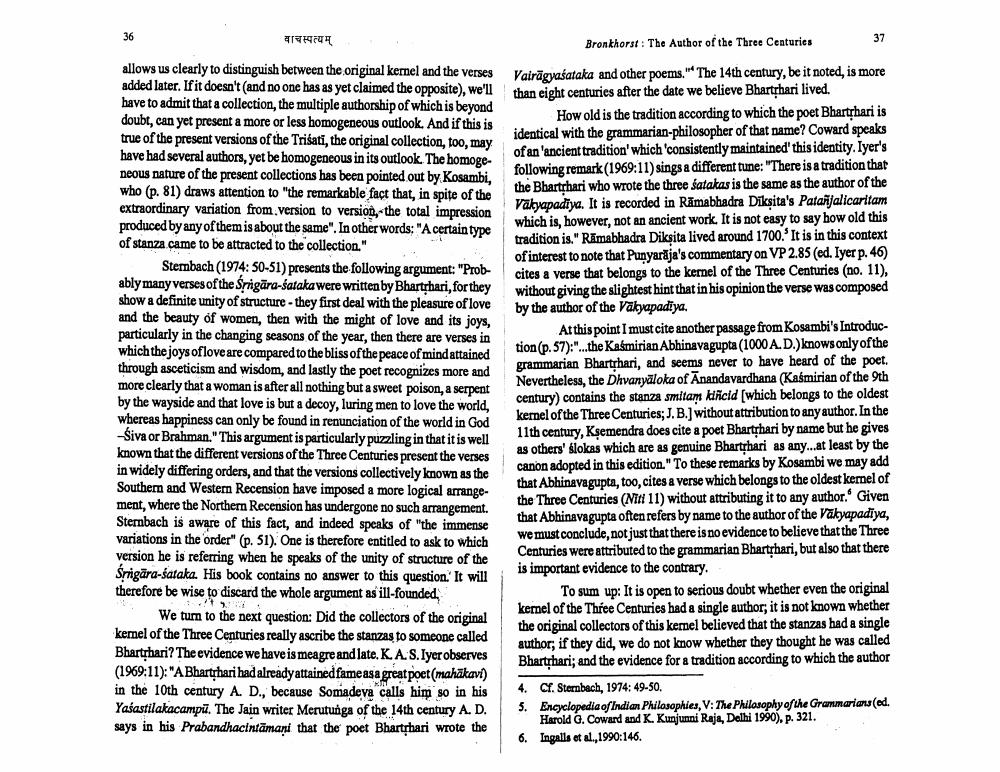Book Title: Author Of Three Centuries Author(s): Johannes Bronkhorst Publisher: Johannes Bronkhorst View full book textPage 3
________________ 36 वाचस्पत्यम् allows us clearly to distinguish between the original kernel and the verses added later. If it doesn't (and no one has as yet claimed the opposite), we'll have to admit that a collection, the multiple authorship of which is beyond doubt, can yet present a more or less homogeneous outlook. And if this is true of the present versions of the Trisati, the original collection, too, may have had several authors, yet be homogeneous in its outlook. The homogeneous nature of the present collections has been pointed out by Kosambi, who (p. 81) draws attention to "the remarkable fact that, in spite of the extraordinary variation from version to version, the total impression produced by any of them is about the same". In other words: "A certain type of stanza came to be attracted to the collection." Sternbach (1974: 50-51) presents the following argument: "Probably many verses of the Srigara-sataka were written by Bhartṛhari, for they show a definite unity of structure - they first deal with the pleasure of love and the beauty of women, then with the might of love and its joys, particularly in the changing seasons of the year, then there are verses in which the joys of love are compared to the bliss of the peace of mind attained through asceticism and wisdom, and lastly the poet recognizes more and more clearly that a woman is after all nothing but a sweet poison, a serpent by the wayside and that love is but a decoy, luring men to love the world, whereas happiness can only be found in renunciation of the world in God -Siva or Brahman." This argument is particularly puzzling in that it is well known that the different versions of the Three Centuries present the verses in widely differing orders, and that the versions collectively known as the Southern and Western Recension have imposed a more logical arrangement, where the Northern Recension has undergone no such arrangement. Sternbach is aware of this fact, and indeed speaks of "the immense variations in the order" (p. 51). One is therefore entitled to ask to which version he is referring when he speaks of the unity of structure of the Srigara-sataka. His book contains no answer to this question.' It will therefore be wise to discard the whole argument as ill-founded, We turn to the next question: Did the collectors of the original kernel of the Three Centuries really ascribe the stanzas to someone called Bhartṛhari? The evidence we have is meagre and late. K. A. S. Iyer observes (1969:11): "A Bharthari had already attained fame as a great poet (mahakavi) in the 10th century A. D., because Somadeva calls him so in his Yasastilakacampu. The Jain writer Merutunga of the 14th century A. D. says in his Prabandhacintamani that the poet Bhartṛhari wrote the 37 Bronkhorst: The Author of the Three Centuries Vairagyasataka and other poems." The 14th century, be it noted, is more than eight centuries after the date we believe Bhartṛhari lived. How old is the tradition according to which the poet Bhartṛhari is identical with the grammarian-philosopher of that name? Coward speaks of an 'ancient tradition' which 'consistently maintained' this identity. Iyer's following remark (1969:11) sings a different tune: "There is a tradition that the Bhartṛhari who wrote the three satakas is the same as the author of the Vakyapadiya. It is recorded in Ramabhadra Diksita's Patanjalicaritam which is, however, not an ancient work. It is not easy to say how old this tradition is." Rämabhadra Diksita lived around 1700.' It is in this context of interest to note that Punyaraja's commentary on VP 2.85 (ed. Iyer p. 46) cites a verse that belongs to the kernel of the Three Centuries (no. 11), without giving the slightest hint that in his opinion the verse was composed by the author of the Vakyapadiya. At this point I must cite another passage from Kosambi's Introduction (p. 57):"...the Kasmirian Abhinavagupta (1000 A.D.) knows only of the grammarian Bhartṛhari, and seems never to have heard of the poet. Nevertheless, the Dhvanyaloka of Anandavardhana (Kasmirian of the 9th century) contains the stanza smitam kiñcid [which belongs to the oldest kernel of the Three Centuries; J. B.] without attribution to any author. In the 11th century, Kṣemendra does cite a poet Bhartṛhari by name but he gives as others' slokas which are as genuine Bhartṛhari as any...at least by the canon adopted in this edition." To these remarks by Kosambi we may add that Abhinavagupta, too, cites a verse which belongs to the oldest kernel of the Three Centuries (Niti 11) without attributing it to any author. Given that Abhinavagupta often refers by name to the author of the Vakyapadiya, we must conclude, not just that there is no evidence to believe that the Three Centuries were attributed to the grammarian Bhartṛhari, but also that there is important evidence to the contrary. To sum up: It is open to serious doubt whether even the original kernel of the Three Centuries had a single author; it is not known whether the original collectors of this kernel believed that the stanzas had a single author, if they did, we do not know whether they thought he was called Bharthari; and the evidence for a tradition according to which the author 4. 5. Cf. Sternbach, 1974: 49-50. Encyclopedia of Indian Philosophies, V: The Philosophy of the Grammarians (ed. Harold G. Coward and K. Kunjunni Raja, Delhi 1990), p. 321. 6. Ingalls et al., 1990:146.Page Navigation
1 2 3 4 5
